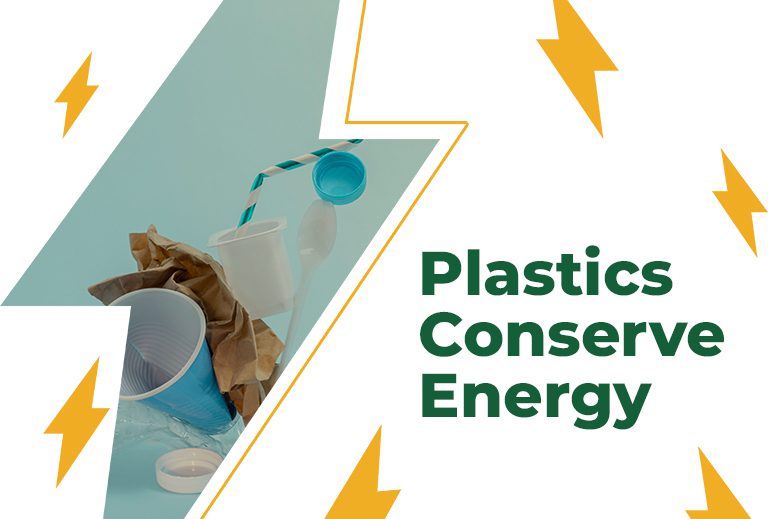5 Underappreciated Ways Plastics Conserve the Planet’s Energy
Plastics conserve energy in several ways that go unnoticed among the general populace.
The energy crisis in the world today is actually countered by the efficiency of plastics. If we had to use different materials in place of plastics, our manufacturing and logistical processes would need more fossil-fuel feedstock to sustain.
Plastics are used in a thousand industries, from lighting to cookware to fire-fighting gear to space suits. And in each of these industries, it offers an energy advantage, which is why its usage is so widespread.
For example, many of us know that LED lighting technology outperforms incandescent lighting in terms of operating lifespan. But it also takes less energy to manufacture the plastic bulb casing in LED lights than the glass bulb casing in the former.
In this post, we outline 5 less-known ways plastics conserve the planet’s energy.
1. The Packaging Industry
A larger percentage of finished goods and perishables are packaged in plastics, be they punnets for farm produce, polystyrene foams for electronic products, or bubble-wrap for fragile crockery and glassware. Despite their abundance, they only make up a small percentage of the packaging’s weight.
When compared to plant-fibre cartons, metal casings, and glass casing, they are thinner and lighter and require less energy to manufacture. For example, you can reduce the weight of a wine bottle by 60-80% when switching from glass to plastics. The plastic bottle saves energy in manufacturing and reduces fuel use in transportation or increases the transported units per trip.
2. The Refrigeration Industry
To keep refrigerator interiors cold, almost all modern refrigerators use layers of plastic foam sandwiched between moulded panels. This not only allows us to keep our food fresher for longer periods of time, but it also means refrigerators don’t have to use as much energy to stay cold, saving money on electricity bills. Insulation is the most important factor in achieving the energy-efficiency ratings that you see on refrigerators.
3. The Building Insulation Industry
Most people spend enormous amounts of energy on air-conditioning in summer and heating in winter. The overworked HVAC systems run extravagant electricity bills. This can also be an issue in workplaces and industrial plants, where heat from the building’s interiors needs to be quickly dissipated to the outside.
With smart insulation practices married to energy-aware architects and builders, plastics insulation can create energy-efficient spaces. An assortment of plastic building components such as plastic foam, foam sealants, plexiglass, expanded polystyrene (EPS), caulks, coatings, and so on, improve a building’s ability to maintain thermal balance without influence from the weather outside. They would also require less energy to manufacture vis-a-vis stone, wood, and glass.
4. The Automotive Industry
Many of the vehicles on today’s roads are largely plastic by volume, yet hardly plastic by weight. The lightweight nature of plastics creates vehicles with better fuel efficiency—heavier vehicles require more fuel consumption. Also, it entails less energy expended in manufacturing, and better standards in safety and design.
You can inspect a car to recognize the extent of plastics usage: from foam dashboards, to polyester seat belts, to the crash-tested plastic film between the window glass panes, to nylon air bags, to the bumpers. All these components define energy-efficiency in the product lifecycle.
5. The Agricultural Industry
Plastics used in greenhouses, ground film, and other plant propagation systems increase crop yield quality and quantity by conserving energy and protecting the crop in the plant’s growing environment. Yield increases of up to 70% have been achieved, as well as out-of-season crop production to meet consumer demand.
While it may seem surprising to the layman, plastics are vital to conserving precious energy while running the world. The more we inspect our own processes, the more we educate ourselves on how to reduce the needless expending of the resources required to build those processes from the ground up.
Leave a Reply Cancel reply
Recent Posts
- Understanding The Materials That Are Used To Build Plastic Toys
- All You Need To Know About Food-grade Plastics
- A Glance At The Materials That Boost The Performance Of Plastics
- Understanding The Importance Of Exploring New Business Opportunities In The Plastic Industry
- Understanding The Importance Of Investing in R&D For The Plastic Industry
Categories
- 3D Printing
- AIPMA
- Automation
- Automobile Sector
- Bio Plastics
- Environment
- Innovations In Recycling
- Latest Innovations
- Molds & Dies
- News
- Packaging Industry
- Plastic
- Plastic Application
- Plastic Industry
- Plastic Market
- Plastic Myths
- Plastic News From The World
- Plastic Packaging
- Plastic Products
- Plastic Recycling
- Plastic Solar Cells
- Plastic Toys
- Plastic Waste
- Plastic World
- Plastics
- Plastics And Their Applications
- Plastics In Agriculture
- Plastics In Healthcare
- Plastics In Medical Industry
- Plasticulture
- Processing Machinery
- Recycling Machines
- Robotics
- Uncategorized
- Virtual Reality
Archives
- November 2023 (3)
- October 2023 (2)
- September 2023 (3)
- August 2023 (3)
- July 2023 (3)
- June 2023 (3)
- May 2023 (2)
- April 2023 (2)
- March 2023 (2)
- February 2023 (2)
- January 2023 (2)
- December 2022 (3)
- November 2022 (1)
- October 2022 (1)
- September 2022 (2)
- August 2022 (1)
- July 2022 (3)
- May 2022 (3)
- March 2022 (2)
- February 2022 (1)
- January 2022 (1)
- September 2021 (2)
- August 2021 (3)
- July 2021 (4)
- June 2021 (4)
- May 2021 (3)
- April 2021 (2)
- March 2021 (4)
- November 2019 (8)
- October 2019 (8)
- September 2019 (8)
- August 2019 (8)
- July 2019 (8)
- June 2019 (8)
- May 2019 (8)
- April 2019 (8)
- March 2019 (8)
- February 2019 (11)
- January 2019 (8)
- December 2018 (8)
- November 2018 (12)
- October 2018 (12)

